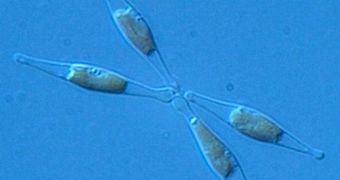Much like ancient scrolls can reveal clues about long-lost civilizations, diatom algae populations can tell scientists much and more about the climate history of a particular area.
This is why investigators at the University of Maine are currently studying lakes in Greenland, in a bid to understand how the Arctic will respond to global warming.
Diatom algae are notorious for being very responsive to changes in their environment. Their behavior and chemical composition can reflect minute changes in oxygen, nitrogen or carbon concentrations both in their lakes, and in the atmosphere above them.
Additionally, these organisms also produce fossils that gather in layers at the bottom of lakes, in effect creating a climate record that can go back millions of years. Researchers led by lake ecologist Jasmine Saros hope to use this resource to figure out how the Arctic responds to climate changes.
The team is currently conducting a series of studies on the lake waters of southwestern Greenland, collecting diatom algae samples from both the water and the fossil record. Their work is supported by the US National Science Foundation (NSF), through its Arctic System Science program.
One of the first things the team discovered was that types of diatom algae usually associated with warmer temperatures are becoming increasingly common in the sediment record, especially in the layers covering the last 150 years. This suggests that microorganisms may already feel the effects of climate change on a small scale.
Interestingly, samples collected from lakes in west Greenland tend to higher concentrations of these algae, when compared to the rest of the Arctic. Additionally, these organisms apparently existed in large numbers throughout the entire Holocene, a period that started around 11,700 years ago.
These abnormal findings prompted researchers to start a new study of diatoms, meant to clarify these organisms' ecological traits. This knowledge could allow us to better understand the factors driving climate change, and how they interact with various ecosystems.
“This research couples comparative lake sampling with both small- and large-scale experiments to provide key ecological information that will enable interpretation of climate-induced ecological changes from several existing diatom records from southwest Greenland,” explains an NSF statement.
During the study, the team will play close attention to how climate change influences the amount of nutrients available in lake waters. Once this process is understood, investigators will apply the conclusions to the fossil record, and reconstruct the climate history of western Greenland.

 14 DAY TRIAL //
14 DAY TRIAL //